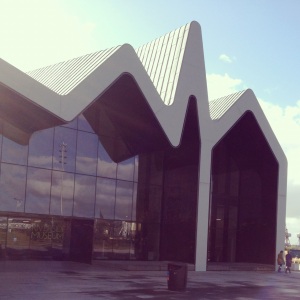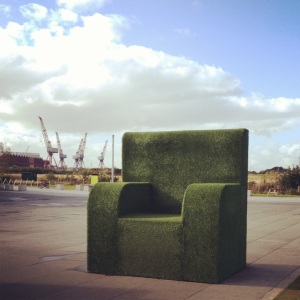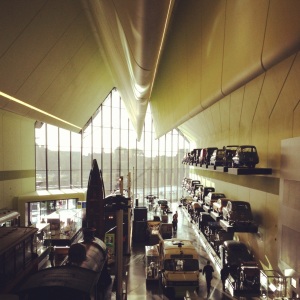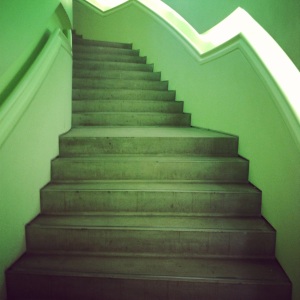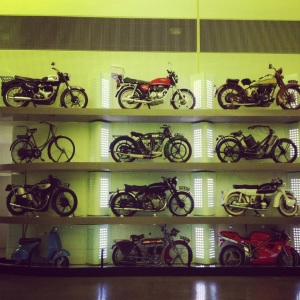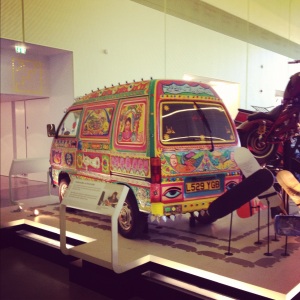
The Annunciation of the Virgin Deal, 2012, detail (image via: anothermag)
If you missed Grayson Perry’s The Vanity of Small Differences exhibition, which was on at the Victoria Miro gallery then I strongly recommend that you visit the William Morris Gallery in north-east London, which will be exhibiting Perry’s Walthamstow Tapestry until 30 September. This large scale (3m x 15m) tapestry explores the impact of branding and advertising on our everyday lives so its theme is similar to the newer tapestries of the Victoria Miro exhibition.
If it is not possible to visit the exhibition or if you want to watch something really interesting and thought provoking then I suggest watching Grayson Perry’s documentary called All In The Best Possible Taste, which aired recently on UK’s Channel 4. The three-part documentary explores how the working, middle and upper classes have developed their sense of taste and how Perry created the six tapestries (two for each social class) for The Vanity of Small Differences exhibition.
It is rather rare for artists to reveal so much information about the creative process behind their work so having the opportunity to watch a TV series where the intentions of the artist have been so well documented is truly unique.
Grayson’s statement that “nothing has such a strong influence on our aesthetic taste as the social class we grow up in” is proven to be quite accurate as he travels through Britain and meets people of different social classes. In the first episode he travels to Sutherland to examine working class taste. In the second episode he goes to Kings Hill, a new development of executive housing in Kent to delve into the taste of middle class and finally in the last part of the series he travels to Cotswolds in Gloucestershire to investigate upper class taste.
Perry’s approach to the sensitive subjects of class and taste is just outstanding and his observations are truly profound. The questions he asks throughout the TV series are so perceptive and manage to retrieve such indicative answers that one has to recognize Grayson’s talent and intuition as a presenter.
A lot of the characters and objects that were encountered whilst filming the documentary are portrayed on the tapestries. The process that Perry followed to create his tapestries involved digitally designing them using Photoshop and then sending them to Flanders to be woven on a computer-controlled loom. Perry said that he chose the medium of tapestry because he enjoys “the idea of using this costly and ancient medium to show the commonplace dramas of modern British life”.
The six tapestries tell a story of class mobility embodied in the character of Tim Rakewell -a clear reference to William Hogarth’s “A Rake’s Progress”, which is a series of eight paintings that tell the story of Tom Rakewell: a young man who inherits a fortune from his father, misspends it, marries for money, goes to prison and finally dies in a madhouse. As Perry explained in the documentary, another influence for the tapestries derives from early renaissance painting, which is his “favourite form of art”. Moreover, his tapestries “to a greater or lesser extent, pay homage to a religious work”.
There are not many TV shows about art so the fact that a documentary on the research and process behind an artist’s work makes it to prime time national TV should give you a hint of Grayson Perry’s genius.
Here are the tapestries:

The Adoration of the Cage Fighters, 2012 (image via: factum-arte)

The Agony in the Car Park, 2012 (image via: factum-arte)
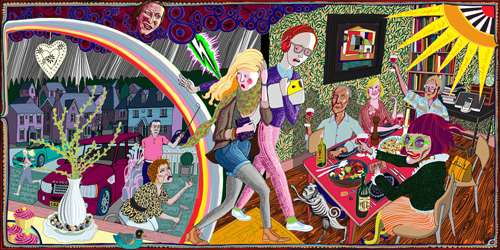
The Expulsion from Number Eight Eden Close, 2012 (image via: factum-arte)

The Annunciation of the Virgin Deal, 2012 (image via: factum-arte)

Grayson Perry in front of The Walthamstow Tapestry, 2009 (image via: trenddelacreme)


